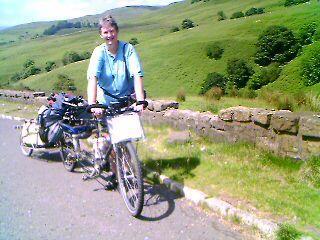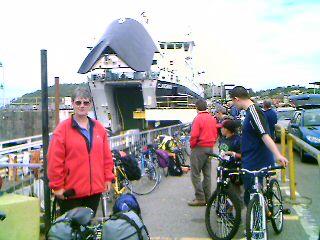The voyage was spectacular even though the BBC is forecasting a summer gale. We left under blue skies on a turquoise sea. The first half of the crossing is between the islands of the Inner Hebrides which rise steeply green to both port and starboard. Astern the mountains rise in the distance. The second half of the four hour trip is in the open sea though we were never quite out of sight of land.
On the approach to Castlebay on Barra the mountains of magical Hebridean islands gradually rose from the blue sea. The grumpy Stoker was woken from her stugeron induced sleep and we were soon in port. It could hardly be more different from Oban. The village is scattered along the rocky shore and just off shore is a well preserved castle on its own little island.
As an aside, the Stoker, who had never been seasick until a disastrous trip in the Management's boat, decided that it was all in the mind and in future she would rely on her trusty sea bands.
We cycled off to our pre booked B&B which we had been lucky to find. The Barrathon, an annual half marathon around the 14 miles of Barra roads, takes place tomorrow. The runners, like us, were disappointed because despite the lovely weather today a "rare" summer storm is forecast for tomorrow.
Day 38 July 2nd Nasg (Barra) to Daliburgh (South Uist)
When we awoke it was already overcast and drizzling. By the time we were ready to leave it was raining steadily. Since the Management did his yachtmaster course he fancies himself as Michael Fish. Warm front going through he says. Not too much wind but lots of warm rain. Then later lots of wind from the south west to push us on our way with sunshine and showers.
Despite forecasting the weather the Management still had what was really a totally inappropriate plan. And even more stupidly he tried to implement it. Over the hill south we went and then just as steeply down. We were going to the Island of Vatersay which is joined to Barra by a causeway. It was not till we had gone for someway into the wind and rain that he agreed that we should turn round.
Back up the hill and down the hill we went to Castlebay. We then dripped on the tourist office floor trying to book some forward accommodation. The Scottish schools are out for the summer and things here are not quite so easy.
We then moved ourselves to drip on the floor of the local café. This is the nearest one to the ferry and is highly recommended, producing some of the nicest food we have had on this trip. And they let us sit there and drip and chat for an hour and a half. During this time they welcomed local people in as well as tourists and even two boys waiting for a bus. We enjoyed it.
The Management's master plan continued, slightly modified. He took the east coast road to the Eriskay ferry rather than the west coast road on the grounds that it was slightly shorter. By now the wind was increasing and we had heard a rumour that the ferry might not run.
We did an unrepeatable and unphotographable ride. We climbed steeply up the foothills of Mount Heaval. We rode up the winding single track roads into the mist. And then back down to the coast. The stormy seas broke over the rocks as we went in and out of rocky bays. There is the occasional house and a profusion of wild life even in the rain. The Management has a lasting memory of a sheep with a flock of at least 15 small birds sitting on its back. They rose as one, disturbed by us, not the sheep.
The ferry crossing of about forty minutes was a bit bumpy. We tied the tandem down as let loose on the car deck it could well do damage. We disembarked and crossed the island of Eriskay, then over the 1.7km causeway to South Uist. Even though it is only three years old the causeway is not wearing well. Presumably the forces of nature were underestimated. Perhaps the designer should have tried cycling or even walking here.
It was a four island day, Vatersay, Barra, Eriskay and South Uist. Compared with the first three the west side of South Uist seemed quite flat. With a following wind we soon arrived at our B&B. Parked in the drive was a parcel company van and a red post office van. Between them our hosts seemed to have cornered the letter and parcel business on this part of the island. We think the B&B season may be very short here and another occupation essential.
Day 39 July 3rd Daliburgh (South Uist) to Hougharry (North Uist)
Our room last night was under the eaves of the house. The wind was noisy as the gale went through. When we awoke the sky was overcast and the sun only occasionally breaking through. It was still very windy and heavy rain showers frequent when we left.
The Management had planned a long ride north on the basis of his weather forecasting. He was right, almost too right. The tail wind was so strong that it made the tandem difficult to steer. And whenever the road deviated from going directly north it was very hard work.
It is hard to say how many islands we rode through today. We certainly cycled three main islands connected by causeways. But the causeways also bridged smaller islands on parts of their length. On several there were signs of storm damage. Even though we thought it windy today, in the spring a storm did huge damage here. There was loss of life when a car was swept off a causeway.
The Uists and Benbecula are low lying to the west with hills and mountains to the east. All of today's cycling was on the west side. It is hard to describe and impossible to capture in a photograph the beauty of this area. Maybe it's the sky, or the colours of the countless lochs. Perhaps it is the big skies. Whatever it is it makes for a great day's cycling. And it almost goes without saying that the roads, which are mostly single track with passing places, are very quiet.
In Benbecular at about 11h40 we came across a Co-op store. It didn't open till 12h30. We waited, shops here are few and far between and mainly closed on Sunday. We brewed up in the trolley shelter. While the kettle boiled the Management tightened the chains which had stretched and did routine technical things which had become pressing. The Stoker talked to another cyclist who happened along. We saw six or seven touring cyclists today all going north with the wind. Most days we see no other cyclists.
So now at the end of the day we are sitting in the lounge of the B&B looking through the large patio windows. It is sunny and windy and we are fifty metres from the sea shore in a wide bay. The white sand of the beach topped with grass covered dunes stretches around to the points. It is also a bird sanctuary. There are few more lovely places anywhere.
Day 40 July 4th Hougharry (North Uist) to Leverburgh (Harris)
The wind had gone down to only just above normal for these windy climes. It was also sunny if a little cold. We made our way to the bird sanctuary visitors centre. It is in a converted blackhouse near an old cemetery. It is unstaffed but the door unlocked and lots of information available.
The RSPB specialises, if that is possible, in corncrakes here. They come to breed in summer. They used to be common throughout the British Isles but now it is a major twitching event if one is seen or heard. Actually it is very unusual to see one even here. They live in the long grass and are very good at hiding.
The cemetery on top of a little rise was interesting. The island was brutally cleared in the 1700's and suffered from the potato famine in the late 1800's. There were still, however, many burials right through these periods. And just as we left the cemetery we heard the unmistakable call of the corncrake.
We left on the single track road which circles the northern part of North Uist. We were in no rush. We ambled along in the sunshine with the wind on our backs. Photo stops were frequent. The spectacular beaches here are absolutely white and stretch for miles. The inland lochs were all shades of blue today and the hills changed colour as the clouds swept by.
The strange thing about the Outer Hebrides is that villages with a centre are rare. There is quite a lot of habitation but the houses are scattered along the roads. During the clearances the tenants were forced from their villages. The countryside was not populated again until after the 1914 - 1918 war. Those who survived settled the land and were granted plots as crofters. The plots were large enough for smallholdings and stretched along the new roads. The consequence is that facilities like shops and schools suddenly appear for no obvious reason in what seem to be the most unlikely places.
Our slow meandering finally came to a total stop for lunch. We were near a beach in the shelter of another fine cemetery wall. Normal cycling did not resume until almost 4pm. The Management had had a snooze, a long snooze in the sun. The Stoker had gone to the beach and been stalking the numerous oyster catchers with a view to a photo opportunity.
We were planning to catch the 17h30 ferry from Berneray to Leverburgh. We just had time to cycle most of the road on Berneray. According to the Rough Guide it was a favourite of Prince Charles. He did not, unlike in Dorchester, seem to have done much damage to the island itself. He did open the causeway from North Uist. We think a ferry would be better. But of course we don't live there.
The ferry now takes cars, unlike the little passenger boat we went on in 1999. The Management sat just under the bridge to watch the complex navigation. It is very shallow here in parts and also very rocky. It looked an interesting job being skipper. At Leverburgh we took a room at the bunk house. It is well equipped, in a lovely position and makes a pleasant change from B&Bs.


